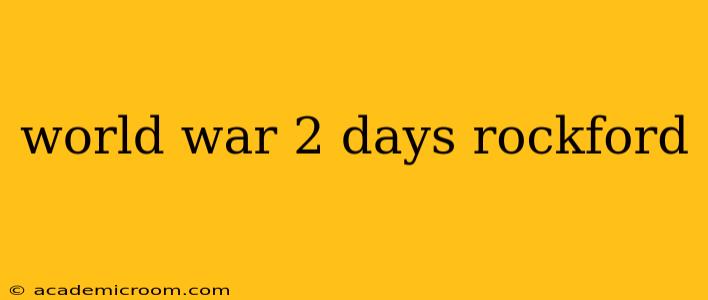Rockford, Illinois, like many American cities, played a vital role during World War II. Far from the front lines, its contributions were crucial to the Allied victory, impacting the lives of its citizens in profound ways. This article explores Rockford's experiences during the war years, examining its industrial output, its role in the home front, and the lasting impact on the community.
What industries in Rockford contributed to the war effort?
Rockford's robust manufacturing base was central to its war contribution. Several key industries stepped up to produce essential materials and equipment. The machine tool industry, a cornerstone of Rockford's economy, was crucial in supplying the tools needed to manufacture war materials. Companies like Sundstrand Machine Tool significantly increased production, providing vital equipment for military vehicles, aircraft, and weaponry. Beyond machine tools, Rockford's factories also contributed to the production of automotive parts, textiles, and other crucial supplies for the military and civilian sectors. The city's factories adapted their production lines to meet the demands of the war, showcasing remarkable adaptability and ingenuity.
How did Rockford's citizens contribute to the war effort on the home front?
The home front in Rockford, like across the nation, experienced significant changes. Rockford citizens participated in rationing programs, conserving essential goods like gasoline, sugar, and rubber. Victory gardens became commonplace, with residents cultivating food to supplement limited supplies. Many Rockford residents also actively participated in war bond drives, lending their financial support to the war effort. Beyond material contributions, the unwavering patriotism and support of Rockford's citizens boosted national morale and played a vital, though less tangible, role in the Allied victory. Women entered the workforce in greater numbers, filling roles vacated by men serving overseas, further demonstrating the city's commitment to the war effort.
What was the impact of World War II on Rockford's population?
The war significantly impacted Rockford's population. The influx of workers from other parts of the country, drawn by job opportunities in the city's booming factories, led to a surge in population. This influx, coupled with the departure of men to serve in the military, dramatically altered the city's demographic landscape. The social fabric of the community also underwent change, with families adjusting to the challenges of separation, rationing, and uncertainty. The war also brought about a significant increase in employment opportunities for women, paving the way for greater gender equality in the workplace, although this progress would continue to evolve after the war’s conclusion.
Did Rockford experience any significant wartime events or incidents?
While Rockford didn't experience direct combat, the city felt the war's impact in various ways. The presence of military personnel and the heightened security measures brought about a noticeable shift in the city's atmosphere. Furthermore, the anxiety and uncertainty surrounding the war’s progress and the safety of loved ones serving overseas deeply impacted the community. The constant news of battles and casualties created a pervasive climate of anxiety and anticipation. While there weren't major incidents like bombings, the fear of attack and the ever-present reality of war significantly altered everyday life in Rockford.
What is the lasting legacy of World War II on Rockford?
World War II left a lasting mark on Rockford. The city's industrial base expanded significantly, leading to long-term economic growth. The experience also fostered a sense of community and resilience among its citizens. The sacrifices made during the war, along with the spirit of unity and determination, shaped Rockford’s identity and left a legacy of civic pride that continues to this day. The contributions of Rockford's citizens and industries remain an integral part of the city's history, serving as a testament to its vital role in the Allied victory. The war’s impact is visible even now in the architecture, the stories passed down through generations, and the overall identity of the community.
This exploration of Rockford's WWII experience highlights the city's crucial contribution to the war effort, both on the industrial front and within the civilian population. The enduring legacy of this period continues to influence the community and serves as a reminder of the collective strength and determination demonstrated during a time of national crisis.
